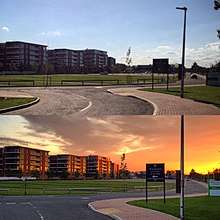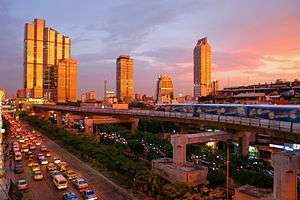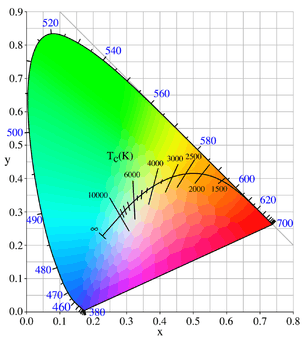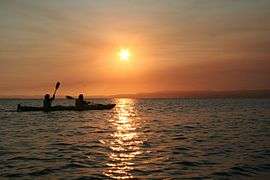Golden hour (photography)


.jpg)
In photography, the golden hour is the period of daytime shortly after sunrise or before sunset, during which daylight is redder and softer than when the Sun is higher in the sky. The opposite period during twilight is blue hour, just before sunrise or after sunset, when indirect sunlight is evenly diffused.[1]
Details

When the Sun is low above the horizon, sunlight rays must penetrate the atmosphere for a greater distance, reducing the intensity of the direct light, so that more of the illumination comes from indirect light from the sky (Thomas 1973, 9–13), reducing the lighting ratio. More blue light is scattered, so if the Sun is present, its light appears more reddish. In addition, the Sun's low angle above the horizon produces longer shadows.
The term hour is used figuratively; the effect has no clearly defined duration and varies according to season and latitude. The character of the lighting is determined by the sun's altitude, and the time for the Sun to move from the horizon to a specified altitude depends on a location's latitude and the time of year (Bermingham 2003, 214). In Los Angeles, California, at an hour after sunrise or an hour before sunset, the sun has an altitude of about 10–12°.[2] For a location closer to the Equator, the same altitude is reached in less than an hour, and for a location farther from the equator, the altitude is reached in more than one hour. For a location sufficiently far from the equator, the Sun may not reach an altitude of 10°, and the golden hour lasts for the entire day in certain seasons.
In the middle of the day, the bright overhead Sun can create strong highlights and dark shadows. The degree to which overexposure can occur varies because different types of film and digital cameras have different dynamic ranges. This harsh lighting problem is particularly important in portrait photography, where a fill flash is often necessary to balance lighting across the subject's face or body, filling in strong shadows that are usually considered undesirable.
Because the contrast is less during the golden hour, shadows are less dark, and highlights are less likely to be overexposed. In landscape photography, the warm color of the low Sun is often considered desirable to enhance the colours of the scene. It is the best time of day for any type of photography since the light is properly diffused and warm.[3]
Gallery
 A salse in the Niland Field during the golden hour. The landscape is grey and low-contrast, but gains colour from the warm yellowish direct sunlight and cool bluish indirect light in the shadows. The low illumination angle also emphasizes the relief of the surface.
A salse in the Niland Field during the golden hour. The landscape is grey and low-contrast, but gains colour from the warm yellowish direct sunlight and cool bluish indirect light in the shadows. The low illumination angle also emphasizes the relief of the surface. Golden hour at sunset in Tasmania, Australia
Golden hour at sunset in Tasmania, Australia
See also
References
- ↑ Pincus, Edward; Ascher, Steven (2012). The Filmmaker’s Handbook: A Comprehensive Guide for the Digital Age. New York: Plume. p. 517.
- ↑ Solar altitude in Los Angeles, CA, at 1 hour after sunrise computed for 21 March, 21 June, 21 September, and 21 December 2009 using the U.S. Naval Observatory Data Services Altitude and Azimuth of the sun or Moon During One Day on 30 July 2009. Values obtained were 11.7°, 10.5°, 11.7°, and 9.75°.
- ↑ "35 Best Sunset Photography Tips and Ideas - PhotographyAxis". PhotographyAxis. 2018-08-02. Retrieved 2018-08-11.
Bibliography
- Bermingham, Alan. 2003. Location Lighting for Television. Boston: Focal Press. ISBN 978-0-240-51937-1
- Lynch, David K., and William Livingston. 1995. Color and Light in Nature. Cambridge: Cambridge University Press. ISBN 0-521-46836-1
- Lynch-Johnt, Barbara A., and Michelle Perkins. 2008. Illustrated Dictionary of Photography: The Professional's Guide to Terms and Techniques. Buffalo, NY: Amherst Media, Inc. ISBN 1-58428-222-3
- Singleton, Ralph S., and James A. Conrad. 2000. Filmmaker's Dictionary. 2nd ed. Ed. Janna Wong Healy. Hollywood, California: Lone Eagle Publishing Company. ISBN 1-58065-022-8
- Thomas, Woodlief, ed. 1973. SPSE Handbook of Photographic Science and Engineering. New York: John Wiley and Sons. ISBN 0-471-81880-1
External links
| Wikimedia Commons has media related to Golden hour (photography). |